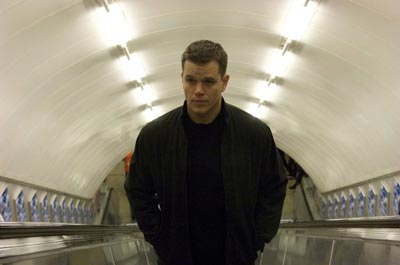
If you see him, say hello, he might be in Tangier. Or Paris, Madrid, London, New York, Moscow…uh, sir, we have Jason Bourne popping up all over the grid here. Shall I put it on One? As you have likely heard, Paul Greengrass’ The Bourne Ultimatum — which I caught last Friday — is a top-notch surveillance thriller that’s easily in keeping with the high standard of excellence put down by Doug Liman in Identity and particularly Greengrass himself in Supremacy. In fact, if there’s a downside to this smart, visceral action flick, which is as excellent as any one can hope for, it’s that it serves to remind us how amazing a Greengrass Watchmen might’ve been. After Bloody Sunday, United 93, and the Bournes, all films characterized by their in-your-face immediacy and gripping visual realism, the man seems incapable of making a bad movie. In any case, he brought the goods here — The Bourne Ultimatum doesn’t have much of a plot, but frankly it doesn’t need one. Like Yen in the suitcase, Jason Bourne is “the Modern Man, disconnected, frightened, paranoid for good reason.“…or at least the Modern Man as he’d aspire to be, if he could speak eight languages fluently, kick all kinds of ass with a library book, and always stay two steps ahead of the great Eye in the Sky.
As Ultimatum begins, we’re back in Moscow at the end of the last film: Bourne (Matt Damon) is on the run from Russian police (as a result of his bravura car chase with Karl Urban), he’s still walking with that limp (suffered from jumping off a bridge in…Amsterdam, was it?), and he’s still confused, amnesic, and obsessive about his origins as a lethal global assassin. So, when he begins experiencing flashbacks involving paunchy government bureaucrats — one of whom speaks with a well-known, recognizable croak — and an abusive interrogation involving hoods and waterboarding, Bourne, like a Frankenstein’s monster of the surveillance age, sets out anew on his mission to discover and confront his creators. (Uh, why doesn’t he just eliminate the middleman and head for Dick Cheney’s office?) In this quest for self-knowledge, Bourne is inadvertently aided by a crusading Guardian reporter (Paddy Considine, of In America and Hot Fuzz), who’s discovered that the super-secret government agency known as Treadstone may have been superseded by a new “sharp end of the stick,” Blackbriar. As you might imagine, this leak does not sit well with VIPs at Langley, so the CIA director (Scott Glenn, more craggy than ever) dispatches suits old (Joan Allen, returning as Pamela Landy) and new (David Strathairn, exuding intelligence in the Chris Cooper/Brian Cox role) to track down and eliminate the source, the reporter, Bourne, and anyone else who gets in their way. And thus the game is on…but who’s the cat and who’s the mouse here? This particular superspy wasn’t Bourne yesterday.
The rest of the film involves Bourne on the run, engaging and evading his would-be captors as much as possible in various scenic vistas around the globe. Yes, you could argue that we’ve seen this all before in the first two films — the CIA suits chattering away in vaguely menacing organizational jargon, the occasional hand-to-hand fisticuffs, the crunchy car carnage — Ultimatum definitely follows a template: Edgar Ramirez shows up in the Clive Owen/Karl Urban role, and Julia Stiles is back as Julia Stiles (and, I’m happy to say, does her best work of the series.) Or one might quibble that Bourne is a bit overpowered — even notwithstanding his superior reflexes, astounding peripheral vision, and brilliant gamesmanship, Bourne’s most powerful weapon might be his ability to induce convenient pangs of conscience among his adversaries at just the right time. But, the play’s the thing, and Greengrass succeeds in making Ultimatum an almost completely immersive experience regardless. Shadowy conversations are filmed from behind the shoulder, drawing attention to furtive eyes and pained grimaces. Observation cameras trace dangerous lines of sight across chaotic crowds, relentlessly seeking out their suspect. And, when the action breaks out…hoo boy. (I think I might’ve preferred the car chase in Supremacy to the very good one here, but there’s a fight in Morocco at one point that is a flat-out doozy.) By the final shot, which not brings the story full circle but recalls a haunting image of Franka Potente’s Marie from II and III, it’s clear that Greengrass is firing on all cylinders right now. I was already impressed with him, but Bourne further suggests that Greengrass is among the very best directors working today — Let’s hope he shares with us more surveillance intel in very short order.


Would like to see more of FRanka Potente
I’ve loved her since Run Lola Run